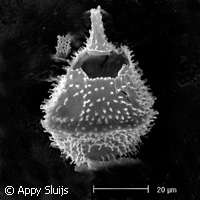Study finds CO2 behind ancient global warming event
A global warming event of the Middle Eocene period 40 million years ago was triggered by increased amounts of carbon dioxide (CO2) in the atmosphere, new EU-funded research shows. The finding, published in the journal Science, could help scientists predict how CO2 may impact global warming in the future. This latest study was funded in part by the DINOPRO ('From Protist to proxy: dinoflagellates as signal carriers for climate and carbon cycling during past and present extreme climate transitions') project, which clinched a European Research Council (ERC) Starting Grant worth EUR 1.5 million under the Seventh Framework Programme (FP7) to develop and apply a sophisticated method for the integrated reconstruction of past changes in carbon cycling and climate change. Experts agree that our planet warmed up for a short time, disrupting the long-term cooling that had been in progress for 10 million years. This hot period, which experts call the Middle Eocene Climatic Optimum (MECO), lasted for 400,000 years. Led by researchers from Utrecht University and the Royal Netherlands Institute for Sea Research, the scientists used an innovative technique, namely organic molecular paleothermometry, on plankton fossils to determine that the atmosphere had absorbed huge amounts of CO2, and that a temperature spike of up to 6°Celsius accompanied the atmospheric CO2 increase. According to the researchers, the causal link between increasing CO2 levels and sea temperatures is consistent with recent models that forecast sea surface temperature hikes of 2 to 5°C for a doubling of CO2. It should be noted that various sites worldwide documented the MECO warming period. 'Our paper is among the first to show that CO2 concentrations and the temperature varied hand in hand in that time,' Reuters quoted Dr Peter Bijl of Utrecht University and lead author of the paper as saying. The finding also adds weight to much speculation about the use of existing climate models. Reuters quoted Jeff Kiehl, chief of the Climate Change Research Section at the National Center for Atmospheric Research in the US, who was not associated with the study, as saying the study describes an actual warming event rather than one predicted by a model. 'This paper shows indeed that the planet is sensitive to CO2 and that this corresponds with a rise in sea surface temperatures,' he said. 'This is something that is independent of a model - this is real data that can be used to test today's models against to see if they agree.' The researchers evaluated core sediment samples gathered from the East Tasman Plateau at Ocean Drilling Program (ODP) Site 1172 in the Southern Ocean. The samples were collected a decade ago by researchers who wanted to recreate the opening between the subcontinents of Antarctica and Australia, which were connected around 40 million years ago. The team evaluated the fossil molecules of the algae to reconstruct the ancient CO2 concentrations. Commenting on the finding, Dr Bijl said: 'To put it briefly, the change in CO2 40 million years ago was too large to have been the result of temperature change and associated feedbacks. Such a large change in CO2 certainly provides a plausible explanation for the changes in Earth's temperature.'
Countries
Netherlands



